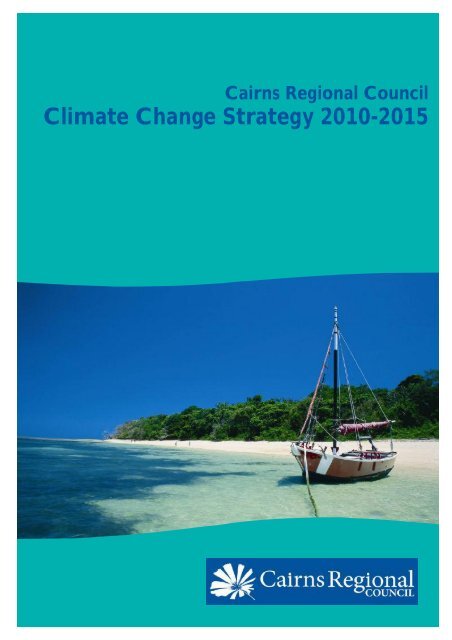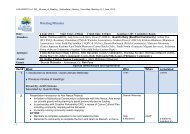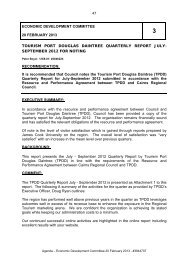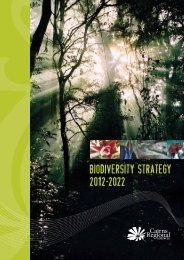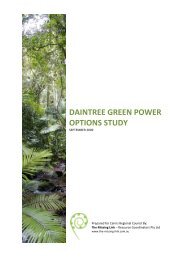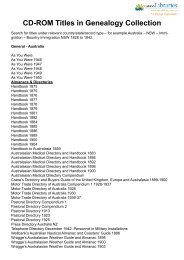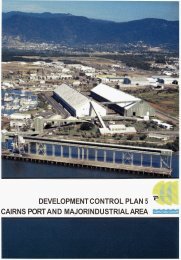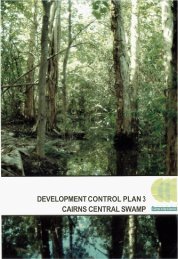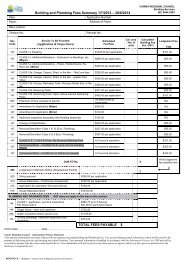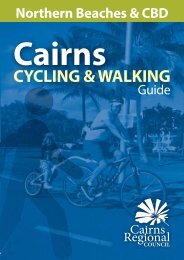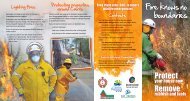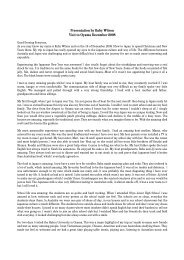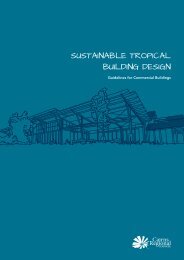Climate Change Strategy 2010 - Cairns Regional Council ...
Climate Change Strategy 2010 - Cairns Regional Council ...
Climate Change Strategy 2010 - Cairns Regional Council ...
Create successful ePaper yourself
Turn your PDF publications into a flip-book with our unique Google optimized e-Paper software.
<strong>Cairns</strong> <strong>Regional</strong> <strong>Council</strong><br />
<strong>Climate</strong> <strong>Change</strong> <strong>Strategy</strong> <strong>2010</strong>-2015<br />
<strong>Cairns</strong> <strong>Regional</strong> <strong>Council</strong> <strong>Climate</strong> <strong>Change</strong> <strong>Strategy</strong> <strong>2010</strong>-2015 - 1 -
This report has been produced by <strong>Cairns</strong> <strong>Regional</strong> <strong>Council</strong> who owns the copyright for<br />
this document.<br />
Adopted by <strong>Council</strong> on 25 August <strong>2010</strong>.<br />
Document #2703612<br />
Disclaimer<br />
Please note that while every effort has been made to ensure that the information contained within<br />
this report is correct and up to date, <strong>Cairns</strong> <strong>Regional</strong> <strong>Council</strong> (CRC) and all persons acting on their<br />
behalf preparing this report accept no liability for the accuracy or inferences from the material contained<br />
in this publication, or for any action as a result of any person’s or groups interpretations deductions<br />
or conclusions relying on this material. CRC accepts no liability for any loss, damage or<br />
injury (including consequential loss, damage or injury) from the use of this information.<br />
This document is printed on 100% recycled paper.<br />
<strong>Cairns</strong> <strong>Regional</strong> <strong>Council</strong> <strong>Climate</strong> <strong>Change</strong> <strong>Strategy</strong> <strong>2010</strong>-2015
Table of Contents<br />
1. Executive Summary .................................................................................................................................... 1<br />
2. <strong>Strategy</strong> Context ........................................................................................................................................ 2<br />
2.1 What is climate change ................................................................................................................... 2<br />
2.2 <strong>Climate</strong> change projections for the Wet Tropics region ........................................................ 2<br />
2.3 Peak Oil and energy transition ....................................................................................................... 3<br />
2.4 Implications for the region .............................................................................................................. 4<br />
2.5 International response ...................................................................................................................... 4<br />
2.6 The Australian response .................................................................................................................. 4<br />
2.7 The Queensland State Government response ........................................................................... 4<br />
3. <strong>Council</strong> response .......................................................................................................................................... 5<br />
3.1 Local context ...................................................................................................................................... 5<br />
3.2 Sphere of influence ............................................................................................................................ 5<br />
3.3 <strong>Council</strong> direction ............................................................................................................................... 5<br />
3.4 Meeting our statutory obligations ................................................................................................. 6<br />
3.5 Why act now .................................................................................................................................... 7<br />
4. The <strong>Strategy</strong> ................................................................................................................................................... 9<br />
4.1 Vision .................................................................................................................................................... 9<br />
4.2 Scope .................................................................................................................................................... 9<br />
4.3 Intent .................................................................................................................................................... 9<br />
4.4 Objectives ........................................................................................................................................... 9<br />
5. <strong>Strategy</strong> outcomes ...................................................................................................................................... 10<br />
6. <strong>Strategy</strong> implementation ......................................................................................................................... 11<br />
6.1 Financial requirements ..................................................................................................................... 11<br />
6.2 Review, success and accountability ............................................................................................... 11<br />
6.3 Key performance indicators ........................................................................................................... 12<br />
6.4 The role of offsets in achieving carbon neutrality ..................................................................... 12<br />
7. References ....................................................................................................................................................... 14<br />
8. Appendices ...................................................................................................................................................... 15<br />
Appendix A – Implementation Plan ..................................................................................................................... 15<br />
Appendix B – <strong>Council</strong>’s Carbon Footprint Analysis ....................................................................................... 21<br />
Appendix C – Community Greenhouse Gas Emissions in the Wet Tropics Region .............................. 22<br />
Appendix D – Recommendations from <strong>Council</strong>’s <strong>Climate</strong> <strong>Change</strong> Adaptation Action Plan ................ 24<br />
<strong>Cairns</strong> <strong>Regional</strong> <strong>Council</strong> <strong>Climate</strong> <strong>Change</strong> <strong>Strategy</strong> <strong>2010</strong>-2015
1. Executive summary<br />
The <strong>Cairns</strong> region is an area of unique natural<br />
beauty, surrounded by tropical rainforests, beaches,<br />
mangroves, mudflats and coral reefs. It is a popular<br />
destination for domestic and international tourists<br />
because of its distinct natural beauty, and is<br />
experiencing high population growth and rapid<br />
expansion. <strong>Climate</strong> change will affect many aspects<br />
of the natural environment and the industries on<br />
which the region depends, making it a critical issue<br />
for the future of the region.<br />
<strong>Council</strong> aims to become a leader in mitigating and<br />
planning for climate change and peak oil, and in<br />
doing so aims to provide guidance and inspiration<br />
for the broader community.<br />
The <strong>Cairns</strong> region, which includes many low-lying<br />
coastal communities, is one of the most vulnerable<br />
areas in Australia to climate change impacts.<br />
Likewise, the region is vulnerable to peak oil impacts<br />
due to its isolation from major centres and sources<br />
of goods and services. This strategy provides a clear<br />
direction for <strong>Council</strong> and the community in<br />
responding to climate change and peak oil, and maps<br />
a course towards a resilient, vibrant and sustainable<br />
future for the region.<br />
<strong>Climate</strong> change is the most significant issue facing<br />
human civilisation. It has the potential to affect every<br />
aspect of human existence, and to have serious<br />
consequences for the earth’s ecosystems. Warming<br />
of above 2°C is predicted to cause runaway climate<br />
change triggering “tipping points” in the Earth’s<br />
systems resulting in irreversible climatic and<br />
ecological changes. Our goal therefore needs to be<br />
to keep warming to below 2°C, which poses an<br />
enormous challenge to our societies and way of life.<br />
Immediate action is required to reduce greenhouse<br />
gas emissions and to begin to prepare communities<br />
for a changed climate. <strong>Climate</strong> change responses<br />
need to encompass not only emission reduction and<br />
adaptation measures, but also behaviour change,<br />
economic restructuring, and building social cohesion<br />
and resilience.<br />
The predicted impacts of climate change on the<br />
<strong>Cairns</strong> region include increasing temperatures,<br />
decreasing annual rainfall, increasing rainfall<br />
seasonality, rising sea levels, and more intense<br />
tropical cyclones. These changes are likely to affect<br />
many aspects of our lifestyle, and are predicted to<br />
have impacts on both the Wet Tropics rainforests<br />
and the Great Barrier Reef. Such impacts have the<br />
potential to undermine the region’s economy which<br />
is heavily reliant on nature based tourism. Sea level<br />
rise and increased cyclone intensity are very likely<br />
to affect <strong>Council</strong> and community assets, and need to<br />
be considered in planning decisions.<br />
<strong>Council</strong> has identified the importance of addressing<br />
climate change and peak oil and the need for a<br />
<strong>Climate</strong> <strong>Change</strong> <strong>Strategy</strong> in the current Corporate<br />
Plan 2009 – 2014. The preparation and adoption of<br />
a holistic climate response in the form of a strategy,<br />
addresses and acknowledges the vulnerability of the<br />
region to these impacts. In addition the <strong>Strategy</strong><br />
presents key actions to be implemented to mitigate<br />
the impacts of climate change and peak oil on the<br />
region.<br />
The purpose of this strategy is to provide clear<br />
direction for responding to climate change risks and<br />
challenges. This strategy builds on <strong>Council</strong>’s existing<br />
climate change policies and programs including the<br />
<strong>Climate</strong> <strong>Change</strong> Adaptation Action Plan and the<br />
Greenhouse Mitigation Action Plan. This strategy<br />
will be assessed and reviewed annually to ensure it<br />
is based on the latest science and policy information.<br />
Responding to climate change is the responsibility of<br />
all areas of <strong>Council</strong>, and will require a coordinated,<br />
collaborative approach in order to successfully make<br />
the transition to a low carbon, low oil and<br />
sustainable future.<br />
- 1 - <strong>Cairns</strong> <strong>Regional</strong> <strong>Council</strong> <strong>Climate</strong> <strong>Change</strong> <strong>Strategy</strong> <strong>2010</strong>-2015
2. <strong>Strategy</strong> context<br />
2.1 What is climate change<br />
<strong>Climate</strong> change refers to a change in the state of the<br />
climate that persists for an extended period,<br />
typically decades or longer. In this document, the<br />
term “climate change” is used to describe human–<br />
induced climate change, and can also be defined as<br />
“a change of climate which is attributed directly or<br />
indirectly to human activity that alters the<br />
composition of the global atmosphere and which is<br />
in addition to natural climate variability observed<br />
over comparable time periods.” 1<br />
Human induced climate change is caused by an<br />
increased concentration of greenhouse gases in the<br />
atmosphere, which trap re-radiated heat and warms<br />
the planet. The general trends are: increasing<br />
temperatures; reduced rainfall (though not in all<br />
locations); changes in rainfall seasonality; increasing<br />
ocean temperatures; changes to ocean currents and<br />
a greater number of extreme weather events such<br />
as storms, fires, droughts and floods. 2<br />
Many of these trends are already being observed,<br />
and climate change is now affecting communities<br />
around the world.<br />
2.2 <strong>Climate</strong> change projections for<br />
the Wet Tropics region<br />
Temperature<br />
• An increase in annual average temperature of<br />
between 0.5 and 1.4°C by 2030 and between<br />
1.0 and 4.2°C by 2070 (compared to 1990<br />
temperatures). 3<br />
• An increase in the number of days above 35°<br />
C from the current annual average of three<br />
days to up to 41 days by 2070. 4<br />
Rainfall<br />
• Overall drier and more seasonal conditions<br />
for the Wet Tropics, characterised by a<br />
longer, drier dry season. 5<br />
• A change in annual average rainfall of between<br />
-6% and +5% by 2030 and between -19% and<br />
+14% by 2070. 6<br />
• Inter-annual rainfall variability is expected to<br />
increase, and rainfall is expected to increase<br />
slightly in the wet season and to decrease<br />
markedly in the late dry season.<br />
• Increased frequency of El Niño events<br />
resulting in lower rainfall and longer dry<br />
seasons.<br />
Sea level rise<br />
• Estimates of total sea-level rise remain<br />
uncertain due to unknown rates of polar ice<br />
cap melting. However, there is growing<br />
consensus among scientists that sea-level rise<br />
of 0.5 to 1.0 metres (compared to 1990 level)<br />
is plausible by 2100, and that a rise of 1.5<br />
metres or more cannot be ruled out. 6 A<br />
conservative prediction of 0.8 metres by 2100<br />
will be used for the purposes of this strategy. 8<br />
Ocean acidification<br />
• As carbon dioxide dissolves into seawater, it<br />
increases the acidity of the ocean by<br />
formation of carbonic acid. This acidification<br />
of the oceans has adverse impacts on marine<br />
life, particularly corals, and presents a major<br />
threat to the health of the Great Barrier Reef.<br />
Cyclones<br />
• While projections of tropical cyclones in the<br />
Australian region are uncertain, available<br />
studies suggest that there may be an increase<br />
in the number of tropical cyclones in the<br />
more intense categories (categories 3–5), but<br />
a possible decrease in the total number of<br />
cyclones. 9<br />
Biodiversity loss<br />
• Changing temperatures, rainfall patterns and<br />
cloud height are predicted to have negative<br />
impacts on plant and animal species in the<br />
Wet Tropics and high levels of species<br />
extinctions are predicted with warming<br />
10, 11<br />
beyond 2°C.<br />
• Increasing ocean temperatures and<br />
acidification may also result in a high degree of<br />
marine biodiversity loss. 12<br />
1<br />
IPCC Glossary of Terms 2007<br />
2<br />
Allison et al 2009<br />
3<br />
Suppiah et al 2007<br />
4<br />
Australian Greenhouse Office 2004<br />
5<br />
Wet Tropics Management Authority 2008<br />
6<br />
Suppiah et al 2007<br />
7<br />
Steffen 2009<br />
8<br />
Sea level rise of 1.1m in <strong>Climate</strong> <strong>Change</strong> Risks to<br />
Australia’s Coast (Department of <strong>Climate</strong> <strong>Change</strong> 2009),<br />
0.8m in the Draft Coastal Management Plan and the South<br />
East Queensland <strong>Climate</strong> <strong>Change</strong> Management Plan<br />
(Queensland Department of Environment and Resource<br />
Management 2009)<br />
9<br />
Short and Woodroffe 2009<br />
10<br />
Still et al 1999<br />
11<br />
Williams et al 2003<br />
12<br />
Hoegh-Guldberg et al 2007<br />
<strong>Cairns</strong> <strong>Regional</strong> <strong>Council</strong> <strong>Climate</strong> <strong>Change</strong> <strong>Strategy</strong> <strong>2010</strong>-2015 - 2 -
2.3 Peak oil and energy transition<br />
Peak oil is a separate issue from climate change, but<br />
is included in this strategy because our responses to<br />
each of these issues need to consider the<br />
implications for the other. Solutions should be<br />
sought that do not address one at the expense of<br />
the other, and preferably that address both.<br />
Peak oil is when global oil fields reach peak<br />
production, after which oil will become more<br />
expensive, increasingly hard to obtain and more<br />
difficult to extract (i.e. the Energy Profit Ratio, the<br />
amount of energy that has to be input to obtain a<br />
given quantity of output, will fall). Our societies rely<br />
on the availability of vast quantities of cheap oil.<br />
There are now signs that the age of cheap oil is<br />
coming to a close. The world’s production of oil has<br />
been rising for at least 100 years, keeping pace with<br />
the rising demand for the product. But the world’s<br />
endowment of oil is finite, and this cannot continue<br />
indefinitely.<br />
The <strong>Cairns</strong> region, located 1700 km from Brisbane<br />
by road, is heavily dependant on road transport for<br />
the supply of food, fuel and other goods. As the cost<br />
of rising oil prices are passed on to the consumer,<br />
the price of goods will go up. Increased use of rail<br />
transport may alleviate this problem, however<br />
increased resilience should be sought by localising<br />
the supply of as many products as possible,<br />
particularly food and energy.<br />
The ‘Queensland’s Vulnerability to rising Oil Prices<br />
Report’ 13 found overwhelming evidence that world<br />
oil production will peak within the next 10 years.<br />
The ‘<strong>Cairns</strong> Oil Vulnerability’ study commissioned<br />
by Queensland Transport in 2007 found that “The<br />
risk of global oil production becoming insufficient to<br />
meet rising global demand is a very real one,<br />
probably within the next five years… The Far North<br />
Queensland region is highly vulnerable to a<br />
tightening of oil supply or a rise in oil prices…This<br />
calls for a risk management approach….local<br />
communities are not helpless but should do as much<br />
as they can to guard against the effects of peak oil,<br />
irrespective of national policy settings.”<br />
This report concluded that every industry in the<br />
region would be detrimentally affected by reduced<br />
oil availability or higher oil prices and found that<br />
early action to adapt to these scenarios would<br />
minimise the negative impacts on the region, both<br />
financially and in terms of community well-being.<br />
Another report, ‘Oil vulnerability in the Australian<br />
City’, found that outer-suburban areas, locations<br />
that contain low socio-economic status populations,<br />
and suburbs which have high levels of car<br />
dependence will be the most affected by oil<br />
shortages and resulting price increases. 14<br />
13<br />
Queensland Government 2007<br />
14<br />
Dodson and Sipe 2005<br />
- 3 - <strong>Cairns</strong> <strong>Regional</strong> <strong>Council</strong> <strong>Climate</strong> <strong>Change</strong> <strong>Strategy</strong> <strong>2010</strong>-2015
2.4 Implications for the region<br />
Tourism – Many tourists visit the region solely<br />
because of the natural beauty of its reefs and<br />
rainforests. Therefore, the region’s tourism industry<br />
would be adversely affected by any damage to these<br />
natural icons. Rising oil prices are also likely to reduce<br />
the number of tourists visiting the region as less<br />
people choose to travel due to increased flight costs.<br />
Infrastructure – Rising sea levels, increased storm<br />
surge levels, and increased intensity of cyclones all<br />
pose risks to public and private infrastructure.<br />
Health – Increased temperatures may increase health<br />
risks such as heat stress and tropical diseases for<br />
vulnerable groups such as the elderly and young<br />
children.<br />
Community well-being - Rising costs of basic goods,<br />
services and electricity will disproportionately affect<br />
residents from low socio-economic backgrounds, and<br />
basic requirements could become unaffordable for<br />
some sectors of the community. As fuel prices<br />
increase, driving may become unaffordable for some<br />
people, and unless low carbon public transport<br />
options are available this will restrict access to<br />
services for residents in outlying suburbs.<br />
2.5 The international response<br />
The issue of climate change has been on the<br />
international agenda since The United Nations<br />
Conference on Environment and Development in Rio<br />
de Janeiro in 1992. Since this time, climate change has<br />
increasingly dominated international environmental<br />
negotiations, and is now widely recognised as the<br />
most serious environmental issue of our time. It is<br />
also an issue that will require a high degree of<br />
international cooperation to resolve.<br />
The international response to climate change is<br />
coordinated by the United Nations Framework<br />
Convention on <strong>Climate</strong> <strong>Change</strong> (UNFCCC) and<br />
regulated by the Kyoto Protocol, which Australia<br />
ratified in 2007.<br />
The Intergovernmental Panel on <strong>Climate</strong> <strong>Change</strong><br />
(IPCC) was set up by the United Nations<br />
Environment Program to conduct and communicate<br />
sound research on climate science. The IPCC<br />
released a report in 2007 stating that to put the<br />
world on track to reduce global greenhouse gas<br />
emissions by at least half of 1990 levels by 2050,<br />
developed countries collectively need to cut their<br />
emissions to 25-40% below 1990 levels by 2020 and<br />
by 80-95% by 2050.<br />
2.6 The Australian response<br />
The Australian government ratified the Kyoto<br />
Protocol in 2007. Australia has committed to<br />
reducing greenhouse gas emissions by 5-25% below<br />
2000 levels by 2020 (depending on the level of<br />
international cooperation), and 60% below 2000<br />
levels by 2050. To assist in achieving this, the Federal<br />
Government has passed the Renewable Energy Target<br />
which commits to generating 20% of Australia’s<br />
electricity supply (45,850 GWh) from renewable<br />
sources by 2020.<br />
2.7 Queensland State Government<br />
response<br />
The Queensland Government’s Towards Q2:<br />
Tomorrow’s Queensland incorporates targets aimed at<br />
protecting local communities from climate change<br />
impacts. These targets include:<br />
• Cutting Queensland’s carbon footprint by one<br />
third by 2020, with a focus on reducing electricity<br />
and motor vehicle use<br />
• Allocating 50 per cent more land for nature<br />
conservation and public recreation to protect<br />
regional biodiversity and will create more natural<br />
carbon sinks to offset emissions<br />
<strong>Regional</strong> climate change actions will also be influenced<br />
by climate change initiatives and policies included in<br />
the following Queensland Government policies:<br />
<strong>Climate</strong>Smart 2050<br />
<strong>Climate</strong>Smart Adaptation 2007-12<br />
<strong>Climate</strong>Q: toward a greener Queensland<br />
FNQ <strong>Regional</strong> Plan 2009-2031<br />
State Coastal Management Plan<br />
<strong>Cairns</strong> <strong>Regional</strong> <strong>Council</strong> <strong>Climate</strong> <strong>Change</strong> <strong>Strategy</strong> <strong>2010</strong>-2015 - 4 -
3. <strong>Council</strong> response<br />
3.1 Local context<br />
The <strong>Cairns</strong> region covers 4,135 km 2 from Bloomfield<br />
in the north, to Miriwinni in the south. The region<br />
extends about 190km from its northern to southern<br />
boundaries, and the eastern boundary is formed by<br />
the Coral Sea coastline abutting the World Heritage<br />
listed Great Barrier Reef Marine Park. Mountains,<br />
beaches, tidal wetlands, freshwater lakes, mudflats,<br />
mangrove swamps, estuaries and coastal plains are<br />
the dominant features of the local environment.<br />
The <strong>Cairns</strong> region is one of the fastest growing<br />
regions in Australia, with more than 3 per cent annual<br />
growth - well above both the State and national<br />
average. The estimated residential population at 30<br />
June 2007 was 152,137. The main industries in the<br />
region are tourism, agriculture and construction.<br />
The major sources of greenhouse gas emissions in the<br />
region are transport (including air travel), agriculture,<br />
land use change, and stationary energy. Refer to<br />
Appendix C for further details on community<br />
emissions.<br />
3.2 Sphere of influence<br />
<strong>Council</strong> acknowledges that it has the ability to<br />
influence many activities that are responsible for<br />
contributing to greenhouse gas emissions. <strong>Council</strong>’s<br />
sphere of influence includes energy generation and<br />
usage, waste management, vegetation management<br />
and land use planning. Land use planning influences<br />
transport behaviour, settlement patterns and<br />
proximity of population centres to economic hubs<br />
and facilities.<br />
<strong>Council</strong> has already undertaken a number of<br />
initiatives to reduce its greenhouse gas emissions and<br />
to embed the principles of sustainability in the<br />
organisation. <strong>Council</strong> has adopted a Corporate<br />
Sustainability Policy, a <strong>Climate</strong> <strong>Change</strong> Adaptation<br />
Action Plan, a Greenhouse Gas Mitigation Action<br />
Plan, and a Carbon Emissions Reduction Policy.<br />
<strong>Council</strong> is also implementing other initiatives including<br />
the Sustainability Scorecard project and the Green<br />
Smart staff education program.<br />
<strong>Council</strong> can further reduce its greenhouse gas<br />
emissions by implementing policies, improving energy<br />
efficiency and waste management technology and<br />
changing behaviour of <strong>Council</strong> staff and the<br />
community. It also has the ability to significantly<br />
reduce community emissions by providing for<br />
adequate low carbon transport options, planning for<br />
compact urban forms and conducting education and<br />
awareness-raising programs to encourage behaviour<br />
change. Refer to Appendix B for an analysis of<br />
<strong>Council</strong>’s current greenhouse gas emissions.<br />
3.3 <strong>Council</strong> direction<br />
Taking action to reduce <strong>Council</strong>’s contribution to the<br />
problem of climate change and to plan for resilience<br />
to climate change and peak oil impacts is supported<br />
by Corporate Plan 2009-2014.<br />
One of the visions of this Plan is that “We will be<br />
Australia’s greenest region”. Relevant goals of the<br />
Plan are to:<br />
• Deliver more environmentally sustainable<br />
<strong>Council</strong> operations and facilities (Goal 1.7)<br />
• Actively reduce <strong>Council</strong>’s greenhouse gas<br />
emissions (Goal 1.8)<br />
• Deliver integrated planning (Goal 3)<br />
• Plan for impacts of climate change including<br />
mitigation and adaptation measures (Goal 3.5)<br />
<strong>Council</strong> has adopted the following documents relating<br />
to climate change and sustainability:<br />
• <strong>Climate</strong> <strong>Change</strong> Adaptation Action Plan<br />
• GHG Mitigation Action Plan<br />
• Carbon Emissions Reduction Policy<br />
• Corporate Sustainability Policy<br />
• Waste Management <strong>Strategy</strong><br />
• Water Demand Management <strong>Strategy</strong> 2009-2012<br />
- 5 - <strong>Cairns</strong> <strong>Regional</strong> <strong>Council</strong> <strong>Climate</strong> <strong>Change</strong> <strong>Strategy</strong> <strong>2010</strong>-2015
3.4 Meeting our statutory<br />
obligations<br />
In future it is likely that <strong>Council</strong> will be required to<br />
comply with greenhouse gas reporting and carbon<br />
permit obligations in the event that an emissions<br />
trading scheme is introduced. This strategy aims to<br />
set a direction towards carbon accountability and<br />
put in place emissions accounting and management<br />
systems that will improve the likelihood of being<br />
able to meet these anticipated requirements.<br />
Given the current uncertainty surrounding the legal<br />
obligations of <strong>Council</strong>s in responding to climate<br />
change, formulating a clear strategy and working<br />
towards mitigating and adapting to climate change<br />
impacts is in the best interest of <strong>Council</strong> as well as<br />
the community.<br />
Community Plan<br />
Under the Local Government Act 2009 Local<br />
Governments are required to produce a long-term<br />
Community Plan that becomes the primary tool to<br />
inform council's Corporate, Financial, Asset<br />
Management plans and influences all other <strong>Council</strong><br />
plans whether they are strategic, operational or<br />
action plans. The Community Plan will be drafted in<br />
consultation with the community and will be<br />
completed by January 2011. Community visions and<br />
objectives identified in the Community Plan that<br />
relate to climate change and peak oil will need to be<br />
addressed by the <strong>Climate</strong> <strong>Change</strong> <strong>Strategy</strong>. Any<br />
necessary changes will be incorporated into the<br />
<strong>Strategy</strong> during the annual review process.<br />
FNQ <strong>Regional</strong> Plan 2009-2031<br />
The FNQ <strong>Regional</strong> Plan 2009-2031 identifies climate<br />
change and oil vulnerability as critical issues in<br />
determining future ecological sustainability of the<br />
region.<br />
The Plan’s regional vision for Far North Queensland<br />
is for a stronger, more liveable and sustainable<br />
community, where people are well educated, well<br />
informed and resilient to the anticipated impacts of<br />
climate change and oil vulnerability.<br />
The Plan outlines that “The impacts of climate<br />
change and rising fuel prices must be addressed and<br />
planned for. The future growth of FNQ must ensure<br />
that greenhouse gas reductions are achieved in<br />
order to mitigate the impacts of climate change.<br />
Strategies must be developed to adapt the region<br />
and build its resilience to such impacts.”<br />
The relevant desired regional outcomes identified by<br />
the Plan are:<br />
1. Natural environment<br />
The region’s terrestrial and aquatic natural assets…<br />
are protected and enhanced to increase their<br />
resilience to the impacts of climate change.<br />
2. <strong>Regional</strong> landscape and natural resources<br />
The environmental, cultural, social and economic<br />
features that comprise the region’s unique tropical<br />
and rural landscapes are identified, maintained and<br />
managed sustainably and are more resilient to the<br />
impacts of climate change.<br />
3. Strong Communities<br />
The region’s communities are vibrant, safe and<br />
healthy and resilient to climate change, and diversity<br />
is welcomed and embraced.<br />
4. Urban Development<br />
The region has an interlinked network of well<br />
planned, discrete, sustainable urban centres which<br />
reflect best practice urban and tropical design and<br />
offer convenient and accessible residential,<br />
employment, transport and other service<br />
opportunities.<br />
5. Economic Development<br />
A strong, ecologically sustainable and diversified<br />
economy, building on new and existing regional and<br />
subregional competitive advantages and<br />
specialisations.<br />
8. Transport<br />
Communities are connected through an integrated<br />
transport system that promotes tourism, public<br />
transport use, walking and cycling, provides safe,<br />
efficient and effective movement of goods and<br />
people, and facilitates access to places and services.<br />
“The available scientific evidence<br />
overwhelmingly indicates that climate<br />
change is a serious global threat demanding<br />
an urgent response” (FNQ <strong>Regional</strong> Plan<br />
2009-2031)<br />
<strong>Cairns</strong> <strong>Regional</strong> <strong>Council</strong> <strong>Climate</strong> <strong>Change</strong> <strong>Strategy</strong> <strong>2010</strong>-2015 - 6 -
State Coastal Management Plan<br />
The State Coastal Management Plan identifies that<br />
coastal areas need to be managed with<br />
consideration to climate change and sea level rise.<br />
Coastal management outcome 2 in this plan is that:<br />
“The coast is managed to allow for natural fluctuations<br />
to occur, including any that occur as a result of climate<br />
change and sea level rise, and provide protection for life<br />
and property.”<br />
To achieve this outcome the Plan outlines the<br />
following principles:<br />
• Trends in climate change including sea level<br />
rise, more extensive storm tide flooding and<br />
associated potential impacts are taken into<br />
account in planning processes.<br />
• Erosion prone areas which exist on open<br />
coasts and along tidal waterways are secured<br />
and maintained largely free from<br />
development.<br />
• The consequences of physical coastal<br />
processes are recognised and such processes<br />
generally are allowed to occur naturally.<br />
• Risks associated with all relevant hazards<br />
including storm tide inundation and cyclone<br />
effects are minimised.<br />
• The natural topography and physical features<br />
of coastal dune systems which provide<br />
adjacent areas with protection from inland<br />
erosion are to be protected and managed on<br />
an ecologically sustainable basis.<br />
This Plan states that planning for the coast must<br />
address the potential impacts of climate change<br />
through the following hierarchy of approaches:<br />
Avoid — focus on locating new development in<br />
areas not vulnerable to the impacts of climate<br />
change;<br />
Planned retreat — focus on systematic<br />
abandonment of land, ecosystems and structures in<br />
vulnerable areas;<br />
Accommodate — focus on continued occupation<br />
of near-coastal areas but with adjustments such as<br />
altered building design; and<br />
Protect — focus on the defence of vulnerable<br />
areas, population centres, economic activities and<br />
coastal resources.<br />
3.5 Why act now<br />
It is now widely accepted that global climate change<br />
is occurring and that it is primarily human induced. 15<br />
While there is still a degree of uncertainty about the<br />
exact nature of predicted impacts, the general<br />
trends are fairly well understood.<br />
Given this knowledge, we cannot wait for greater<br />
certainty before acting, but have a responsibility to<br />
act now to protect the community and the natural<br />
environment. It is in the best interest of <strong>Council</strong> and<br />
the community to act immediately to mitigate our<br />
impacts and prepare for the changes to come.<br />
“The earlier effective action is taken,<br />
the less costly it will be” 16<br />
<strong>Climate</strong> change and peak oil have the potential to<br />
affect every aspect of our lives, from the health and<br />
integrity of natural systems, to economic prosperity<br />
and community health and well-being. Making the<br />
transition now to a low carbon, low oil economy<br />
will give the region a competitive advantage and help<br />
to avoid the worst of the negative economic,<br />
environmental and social impacts.<br />
15<br />
Allison et al 2009, IPCC 2007<br />
16<br />
Stern 2006<br />
- 7 - <strong>Cairns</strong> <strong>Regional</strong> <strong>Council</strong> <strong>Climate</strong> <strong>Change</strong> <strong>Strategy</strong> <strong>2010</strong>-2015
<strong>Cairns</strong> <strong>Regional</strong> <strong>Council</strong> <strong>Climate</strong> <strong>Change</strong> <strong>Strategy</strong> <strong>2010</strong>-2015 - 8 -
4. The <strong>Strategy</strong><br />
4.1 Vision<br />
To create a roadmap that will lead to a<br />
low carbon, low oil, sustainable future for<br />
the <strong>Cairns</strong> region<br />
4.2 Scope<br />
The <strong>Cairns</strong> <strong>Regional</strong> <strong>Council</strong> <strong>Climate</strong> <strong>Change</strong><br />
<strong>Strategy</strong> will provide clear direction for addressing<br />
climate change and peak oil vulnerability in the<br />
<strong>Cairns</strong> region. It will draw together and build on<br />
current <strong>Council</strong> projects, policies and plans that<br />
relate to climate change and sustainability to create<br />
a unified strategy for responding to these issues,<br />
capitalising on related opportunities, and leading the<br />
community towards sustainability.<br />
4.3 Intent<br />
To inform council’s response to climate change,<br />
direct action to minimise <strong>Council</strong>’s and the<br />
community’s contribution to the causes of climate<br />
change, and enhance the resilience of <strong>Council</strong> and<br />
the community to potential impacts from climate<br />
change.<br />
4.4 Objectives<br />
The objectives of this strategy are to:<br />
• build capacity of <strong>Council</strong> to lead the community<br />
in responding to climate change<br />
• ensure <strong>Council</strong> can continue to deliver its<br />
services effectively to the community in a<br />
changing climate<br />
• reduce the vulnerability of the <strong>Cairns</strong><br />
community to climate change impacts<br />
• ensure <strong>Council</strong>’s response to climate change is<br />
relevant and informed by research,<br />
international protocols and current standards<br />
• provide a clear plan for how to mitigate and<br />
adapt to climate change and meet <strong>Council</strong>’s<br />
statutory obligations<br />
• integrate climate change considerations into<br />
<strong>Council</strong> decision-making processes and<br />
governance structures<br />
• inspire the community by demonstrating<br />
leadership in addressing climate change<br />
- 9 - <strong>Cairns</strong> <strong>Regional</strong> <strong>Council</strong> <strong>Climate</strong> <strong>Change</strong> <strong>Strategy</strong> <strong>2010</strong>-2015
5. <strong>Strategy</strong> outcomes<br />
The strategic outcomes of the <strong>Strategy</strong> have been<br />
divided into four categories: leadership; mitigation;<br />
adaptation and transition. These strategic outcomes<br />
are:<br />
Leadership<br />
• Improved and innovative <strong>Council</strong> leadership<br />
and practices in addressing climate change<br />
risks and opportunities<br />
• Improved understanding of locally relevant<br />
research informing <strong>Council</strong>’s response to<br />
climate change<br />
• Increased capacity for <strong>Council</strong> and community<br />
to respond to climate change through<br />
partnerships and advocacy<br />
• Increased investment in climate change<br />
opportunities and technology in the region<br />
Mitigation<br />
• <strong>Council</strong> on track to achieve the goal of 50%<br />
reduction on 2007/2008 levels and to be<br />
carbon neutral by 2020<br />
• Increased community participation in<br />
addressing climate change, and greater<br />
community awareness of the need for action<br />
through engagement, partnership and planning<br />
• A plan for reducing community emissions<br />
• Reduced community emissions through<br />
considered land use planning for low carbon<br />
communities<br />
Adaptation<br />
• Informed and integrated adaptation responses<br />
to climate change that meet <strong>Council</strong>’s<br />
statutory obligations to protect the<br />
community and the environment<br />
• Improved resilience of <strong>Council</strong>’s<br />
infrastructure to the impacts of climate<br />
change<br />
Transition<br />
• Reduced oil and carbon dependency and<br />
increased community resilience to climate<br />
change and peak oil impacts<br />
<strong>Cairns</strong> <strong>Regional</strong> <strong>Council</strong> <strong>Climate</strong> <strong>Change</strong> <strong>Strategy</strong> <strong>2010</strong>-2015 - 10 -
6. <strong>Strategy</strong> implementation<br />
Key actions have been developed for achieving each<br />
of the strategic outcomes listed. These actions are<br />
included in the Implementation Plan (see Appendix<br />
A).<br />
6.1 Financial requirements<br />
To effectively implement this <strong>Strategy</strong>, <strong>Council</strong> will<br />
need to allocate adequate funding and human<br />
resources. In addition it will be important to commit<br />
to capacity development across the organisation.<br />
Achieving the objectives identified in this <strong>Strategy</strong><br />
will require centralised coordination, as well as<br />
regular monitoring, measuring and reporting.<br />
The key actions identified in this <strong>Strategy</strong> will come<br />
at varying degrees of cost and resource<br />
requirements. Some objectives could be achieved<br />
with minimal cost increases, with costs embedded in<br />
existing operational costs.<br />
Other objectives, however, will require substantial<br />
financial support if <strong>Council</strong>’s goals of mitigating and<br />
adapting to climate change risks and capitalising on<br />
associated opportunities are to be achieved. The<br />
climate change strategy will require a dedicated and<br />
ongoing budget of approximately $700,000 per<br />
annum to ensure the actions documented in the<br />
implementation plan are followed through.<br />
Opportunities for partnerships could reduce the<br />
overall cost of action for <strong>Council</strong>, enabling the full<br />
cost of action to be shared with other stakeholders.<br />
6.2 Review, success and<br />
accountability<br />
<strong>Council</strong> will integrate its climate change response<br />
into governance and decision making frameworks<br />
and will be transparent and accountable for enacting<br />
the strategy. The implementation of the <strong>Strategy</strong> will<br />
be the responsibility of all staff across the<br />
organisation.<br />
The actions in this <strong>Strategy</strong> will require input from<br />
all areas of <strong>Council</strong>. The General Manager of each<br />
Department will be responsible for ensuring any<br />
actions assigned to their team are implemented. Due<br />
to the broad range of actions, implementation will<br />
need to be well integrated into annual Operational<br />
Plans and well monitored to ensure success.<br />
This <strong>Strategy</strong> will be reviewed annually, and progress<br />
towards key outcomes will be evaluated at this time.<br />
The review will be undertaken by <strong>Council</strong>’s climate<br />
change team.<br />
The success of <strong>Council</strong>’s <strong>Climate</strong> <strong>Change</strong> <strong>Strategy</strong><br />
will be measured in a variety of ways. <strong>Council</strong><br />
conducts an annual greenhouse inventory in<br />
accordance with National Greenhouse and Energy<br />
Reporting System (NGERS) methodology which<br />
provides an annual carbon footprint (see Appendix B<br />
for <strong>Council</strong> emissions analysis). <strong>Council</strong> also reports<br />
on sustainability indicators as part of the annual<br />
State of the Environment Report and Sustainability<br />
Scorecard.<br />
The key performance indicators in section 6.3 will<br />
be used to measure <strong>Council</strong>’s performance towards<br />
implementing the <strong>Climate</strong> <strong>Change</strong> <strong>Strategy</strong>.<br />
- 11 - <strong>Cairns</strong> <strong>Regional</strong> <strong>Council</strong> <strong>Climate</strong> <strong>Change</strong> <strong>Strategy</strong> <strong>2010</strong>-2015
6.3 Key Performance Indicators<br />
# KEY PERFORMANCE INDICATOR DATA SOURCED<br />
FROM<br />
1 Percentage by which <strong>Council</strong>’s total greenhouse gas emissions are<br />
reduced<br />
Annual greenhouse gas<br />
inventory<br />
2 Percentage by which <strong>Council</strong>’s consumption of Petrol and Diesel is<br />
reduced<br />
Annual greenhouse gas<br />
inventory<br />
3 Number of <strong>Council</strong> decisions that consider climate change or peak Sustainability scorecard<br />
oil<br />
4 Number of <strong>Council</strong> Policies and Plans that incorporate <strong>Climate</strong> Sustainability Officer<br />
<strong>Change</strong> or Peak oil considerations<br />
5 Percentage of <strong>Council</strong> staff that undertake training for climate<br />
change considerations<br />
Staff induction/Human Resources<br />
6 Percentage of <strong>Cairns</strong> region mapped for the impacts of sea level Disaster Management<br />
rise and storm surge<br />
7 Percentage of total government funding and grants received by Sustainability Officer<br />
<strong>Council</strong> that are for climate change initiatives<br />
8 Percentage decrease in community and <strong>Council</strong> waste going to Water and Waste<br />
landfill<br />
9 Percentage of <strong>Council</strong> buildings with renewable energy generation Facilities Maintenance<br />
capacity<br />
10 Percentage of <strong>Council</strong>’s energy use that is generated from renewable<br />
Greenhouse gas inventory<br />
resources<br />
11 Percentage decrease in energy consumption across <strong>Council</strong> buildings<br />
Greenhouse gas inventory<br />
and assets<br />
12 Percentage increase in public and active transport use by the <strong>Cairns</strong><br />
community<br />
Census, FNQROC,<br />
Queensland Transport<br />
13 Percentage of <strong>Council</strong> staff commuting to work by public or active Staff survey<br />
transport or car pooling<br />
14 Number of public climate change and peak oil presentations or Sustainability Officer<br />
events conducted by <strong>Council</strong><br />
15 Percentage increase in number of <strong>Council</strong> buildings abiding by the Sustainability Officer<br />
‘Sustainable Design Principles’<br />
16 Percentage increase in the proportion of trees planted in public<br />
spaces that produce edible fruit (by humans)<br />
Infrastructure Services<br />
6.4 The role of offsets in achieving carbon neutrality<br />
<strong>Council</strong> will follow the hierarchy of “measure, avoid, reduce, offset” on the path to becoming carbon neutral.<br />
MEASURE EMISSIONS<br />
<strong>Council</strong> will measure their emissions by implementing<br />
an Energy and Emissions Data Management System.<br />
AVOID AND REDUCE EMISSIONS<br />
OFFSET EMISSIONS<br />
<strong>Council</strong> will avoid, reduce and replace emissions<br />
through the mitigation actions listed in the Implementation<br />
Plan, the GHG Mitigation Action Plan and<br />
the <strong>Climate</strong> <strong>Change</strong> Adaptation Action Plan.<br />
<strong>Council</strong> will offset residual emissions to achieve carbon<br />
neutrality.<br />
<strong>Cairns</strong> <strong>Regional</strong> <strong>Council</strong> <strong>Climate</strong> <strong>Change</strong> <strong>Strategy</strong> <strong>2010</strong>-2015 - 12 -
Guidelines for purchasing carbon offsets<br />
Carbon offsetting is where consumers voluntarily<br />
pay or undertake activities to reduce or remove a<br />
certain amount of carbon dioxide from the<br />
atmosphere, to compensate for another carbon<br />
dioxide emitting activity. The premise is that by<br />
funding projects that would not happen without the<br />
offset funding, the sale of carbon offsets can result in<br />
important investments in a low carbon future.<br />
When selecting carbon offset projects, <strong>Council</strong> will<br />
endeavour to:<br />
• preference and encourage local carbon offset<br />
projects<br />
• preference projects that provide emission<br />
reductions rather than carbon sequestration<br />
• purchase carbon offsets accredited under the<br />
Clean Development Mechanism (CDM), Gold<br />
Standard, Greenhouse Friendly or Voluntary<br />
Carbon Standard (VCS)<br />
• preference offset providers ranked as<br />
‘Outstanding’ by Carbon Offset Watch<br />
Some examples of carbon offset projects<br />
Renewable energy: ‘Clean’ energy is generated<br />
from sources like water, wind and sun. This means<br />
coal-based energy production is avoided, so there<br />
are fewer carbon emissions.<br />
Trees/forestry projects: Trees remove<br />
(‘sequester’) carbon from the atmosphere. So projects<br />
that avoid deforestation or plant new trees<br />
can result in a net reduction in atmospheric CO2.<br />
Energy efficiency projects: Perhaps the most<br />
effective way to reduce emissions is to use less energy,<br />
and use it more efficiently. For the purposes<br />
of offsets, a company might set up projects that<br />
increase energy efficiency and sell credits for the<br />
resulting emission reduction as a carbon offsets. 17<br />
17<br />
Carbon Offset Watch, <strong>2010</strong><br />
- 13 - <strong>Cairns</strong> <strong>Regional</strong> <strong>Council</strong> <strong>Climate</strong> <strong>Change</strong> <strong>Strategy</strong> <strong>2010</strong>-2015
7. References<br />
Allison I., Bindoff N.L., Bindschadler R.A., Cox P.M., de Noblet N., England M.H., Francis J.E., Gruber N.,<br />
Haywood A.M.,. Karoly D.J, Kaser G., Le Quéré C., Lenton T.M., Mann M.E., McNeil B.I., Pitman A.J., Rahmstorf<br />
S., Rignot E., Schellnhuber H.J., Schneider S.H., Sherwood S.C., Somerville R.C.J., Steffen K., Steig E.J., Visbeck<br />
M., Weaver A.J. (2009) The Copenhagen Diagnosis, 2009: Updating the World on the Latest <strong>Climate</strong> Science. The<br />
University of New South Wales, <strong>Climate</strong> <strong>Change</strong> Research Centre, Sydney, Australia, 60pp.<br />
Australian Greenhouse Office (2004) <strong>Climate</strong> <strong>Change</strong> in the <strong>Cairns</strong> and Great Barrier Reef Region: Scope for an<br />
Integrated Assessment.<br />
Queensland Transport (2007) <strong>Cairns</strong> Oil Vulnerability, prepared by Kilsby Australia Pty Ltd, Chatswood NSW.<br />
Carbon Offset Watch (<strong>2010</strong>) www.carbonoffsetwatch.org.au<br />
Dodson J. and Sipe N. (2005) Oil Vulnerability in the Australian City. Research Paper 6, Urban Research Program,<br />
Griffith University, Brisbane.<br />
Hoegh-Guldberg O., Mumby P. J., Hooten A. J., Steneck R. S., Greenfield P., Gomez E., Harvell C. D., Sale P. F.,<br />
Edwards A. J., Caldeira K., Knowlton N., Eakin C. M., Iglesias-Prieto R., Muthiga N., Bradbury R. H., Dubi A.,<br />
Hatziolos M. E. (2007) Coral Reefs Under Rapid <strong>Climate</strong> <strong>Change</strong> and Ocean Acidification. Science,<br />
318:5857,1737 – 1742.<br />
IPCC (2007) Summary for Policymakers. In: <strong>Climate</strong> <strong>Change</strong> 2007: The Physical Science Basis. Contribution of<br />
Working Group I to the Fourth Assessment Report of the Intergovernmental Panel on <strong>Climate</strong> <strong>Change</strong> [Solomon, S., D.<br />
Qin, M. Manning, Z. Chen, M. Marquis, K.B. Averyt, M.Tignor and H.L. Miller (eds.)]. Cambridge University<br />
Press, Cambridge, United Kingdom and New York, NY, USA.<br />
Queensland Government (2007) <strong>Climate</strong>Smart 2050 Queensland climate change strategy 2007: a low carbon future.<br />
Steffen W. (2009) <strong>Climate</strong> <strong>Change</strong> 2009: faster change and more serious risks. Department of <strong>Climate</strong> <strong>Change</strong>,<br />
Canberra, ACT.<br />
Short A. and Woodroffe C. (2009) The Coast of Australia, Cambridge University Press, Melbourne, 288pp.<br />
Stern N. (2006) The Economics of <strong>Climate</strong> <strong>Change</strong>. Report commissioned by the British Government, UK.<br />
Still C. J., Foster N. F. & Schneider S. H. (1999) ‘Simulating the effects of climate change on tropical montane<br />
cloud forests’ Nature 398, 608-610.<br />
Suppiah R., Macadam I. and Whetton P. H. (2007) <strong>Climate</strong> <strong>Change</strong> Projections for the Tropical Rainforest Region of<br />
North Queensland. Unpublished report to the Marine and Tropical Sciences Research Facility. Reef and<br />
Rainforest Research Centre Limited, <strong>Cairns</strong>, 38pp.<br />
Wet Topics Management Authority (2007) Greenhouse Gas Emissions in the Wet Tropics Region: A Preliminary<br />
Inventory, prepared by Marsden Jacobs Associates Pty Ltd, Brisbane.<br />
Wet Topics Management Authority (2008) <strong>Climate</strong> <strong>Change</strong> in the Wet Tropics: Impacts and Responses in State of<br />
the Wet Tropics Report 2007-2008.<br />
Williams S.E., Bolitho E.E. and Fox S. (2003) ‘<strong>Climate</strong> change in Australian tropical rainforests: an impending<br />
environmental catastrophe’ Proc. R. Soc. Lond. B,1887-1892.<br />
<strong>Cairns</strong> <strong>Regional</strong> <strong>Council</strong> <strong>Climate</strong> <strong>Change</strong> <strong>Strategy</strong> <strong>2010</strong>-2015 - 14 -
8. Appendices<br />
APPENDIX A - <strong>Climate</strong> <strong>Change</strong> <strong>Strategy</strong> Implementation plan<br />
Leadership<br />
Strategic outcome 1. Improved and innovative <strong>Council</strong> leadership and practices in addressing climate change risks and<br />
opportunities<br />
Key Performance Indicators: 3, 4, 14<br />
Key action<br />
Cost<br />
Annual<br />
emission<br />
savings<br />
(tCO2 e)<br />
Responsibility<br />
When<br />
Related<br />
documents<br />
1<br />
Integrate relevant visions and objectives from the<br />
Community Plan into this <strong>Strategy</strong> during annual<br />
review.<br />
Low or<br />
embedded<br />
cost^<br />
Not<br />
applicable<br />
Corporate<br />
Performance,<br />
Planning Strategies<br />
2011-2012<br />
Community<br />
Plan<br />
2<br />
Integrate climate change and peak oil considerations<br />
into <strong>Council</strong>'s Corporate Plan<br />
Low or<br />
embedded cost<br />
Not<br />
applicable<br />
Organisation-wide 2014<br />
Corporate<br />
Plan<br />
3<br />
Ensure climate change and peak oil considerations<br />
are included in <strong>Council</strong>'s policies and strategies<br />
Low or<br />
embedded cost<br />
Not<br />
applicable<br />
Organisation-wide<br />
Ongoing<br />
All <strong>Council</strong><br />
documents<br />
4<br />
Include climate change as a causation in the<br />
Corporate Risk Framework and identify clear risk<br />
treatments to embed a system of climate change risk<br />
assessment in corporate decision making<br />
Low or<br />
embedded cost<br />
This is an<br />
adaptation<br />
action<br />
Corporate<br />
Performance<br />
<strong>2010</strong>-2011<br />
5<br />
Integrate climate change and peak oil considerations<br />
into <strong>Council</strong> reports by implementing the<br />
Sustainability Scorecard<br />
Low or<br />
embedded cost<br />
Not<br />
applicable<br />
Organisation-wide <strong>2010</strong>-2011<br />
6<br />
Integrate Sustainability Scorecard tools into<br />
<strong>Council</strong>'s procurement and decision-making<br />
frameworks<br />
Low or<br />
embedded cost<br />
Emissions<br />
savings<br />
unknown<br />
Planning Strategies <strong>2010</strong>-2011<br />
7<br />
Demonstrate good governance by informing the<br />
general community about climate change and peak<br />
oil impacts and risks<br />
Low or<br />
embedded cost<br />
This is an<br />
adaptation<br />
action<br />
Planning Strategies<br />
Ongoing<br />
8<br />
Make technical information available to the public<br />
regarding climate change risks<br />
Low or<br />
embedded cost<br />
This is an<br />
adaptation<br />
action<br />
Planning Strategies,<br />
Disaster<br />
Management<br />
Ongoing<br />
9<br />
Provide an annual progress report to <strong>Council</strong> on<br />
<strong>Strategy</strong> implementation<br />
Low or<br />
embedded cost<br />
Not<br />
applicable<br />
Planning Strategies<br />
Ongoing<br />
Leadership<br />
Strategic outcome 2. Improved understanding of locally relevant research informing <strong>Council</strong>’s response to climate change<br />
10<br />
Key action<br />
Monitor the latest climate change science and<br />
international best practice standards for addressing<br />
climate change and peak oil and update <strong>Council</strong>'s<br />
response accordingly<br />
Cost<br />
Low or embedded<br />
cost<br />
Annual emission<br />
savings (tCO2 e)<br />
Not applicable<br />
Responsibility<br />
Planning<br />
Strategies<br />
When<br />
Ongoing<br />
- 15 - <strong>Cairns</strong> <strong>Regional</strong> <strong>Council</strong> <strong>Climate</strong> <strong>Change</strong> <strong>Strategy</strong> <strong>2010</strong>-2015
Leadership<br />
Strategic outcome 3. Increased capacity for <strong>Council</strong> and community to respond to climate change through<br />
partnerships and advocacy<br />
Key Performance Indicators: 5, 7<br />
Key action<br />
Cost<br />
Annual<br />
emission<br />
savings<br />
(tCO2 e)<br />
Responsibility<br />
When<br />
11<br />
Identify and pursue external funding opportunities for<br />
collaborative projects<br />
Low or<br />
embedded cost<br />
Not<br />
applicable<br />
Organisation-wide<br />
Ongoing<br />
12<br />
Engage and share information with neighbouring <strong>Council</strong>s on<br />
regional projects<br />
Low or<br />
embedded cost<br />
Emissions<br />
savings<br />
unknown<br />
FNQROC<br />
Ongoing<br />
13<br />
Develop staff learning opportunities that will equip staff to<br />
identify and respond to climate change and peak oil risks<br />
Dependant on<br />
opportunities<br />
developed<br />
Not<br />
applicable<br />
Planning Strategies,<br />
Human Resources<br />
Ongoing<br />
14<br />
Establish a cross-departmental climate change team to<br />
coordinate <strong>Council</strong>’s climate change response<br />
Low or<br />
embedded cost<br />
Not<br />
applicable<br />
Organisation-wide <strong>2010</strong><br />
15<br />
Include climate change and sustainability in staff induction<br />
training<br />
Low or<br />
embedded cost<br />
Not<br />
applicable<br />
Human Resources <strong>2010</strong><br />
Leadership<br />
Strategic outcome 4. Increased investment in climate change opportunities and technology in the region<br />
Key Performance Indicator: 10<br />
Key action<br />
Cost<br />
Annual emission<br />
savings (tCO2 e)<br />
Responsibility<br />
When<br />
16<br />
Encourage and investigate options for alternative<br />
fuel and renewable energy production in the<br />
region<br />
Low or embedded<br />
cost<br />
Emissions savings<br />
unknown<br />
Economic<br />
Development<br />
Officer<br />
Ongoing<br />
17<br />
In partnership with industry and State<br />
Government, support initiatives that attract low<br />
carbon investment<br />
Low or embedded<br />
cost<br />
Emissions savings<br />
unknown<br />
Economic<br />
Development<br />
Officer<br />
Ongoing<br />
18<br />
Investigate options for <strong>Council</strong>-owned renewable<br />
energy generation facilities<br />
Low or embedded<br />
cost<br />
Emissions savings<br />
unknown<br />
AMDP <strong>2010</strong>-2012<br />
<strong>Cairns</strong> <strong>Regional</strong> <strong>Council</strong> <strong>Climate</strong> <strong>Change</strong> <strong>Strategy</strong> <strong>2010</strong>-2015 - 16 -
Mitigation<br />
Strategic outcome 5. <strong>Council</strong> on track to achieve the goal of 50% reduction on 2007/2008 levels and to be carbon neutral<br />
by 2020<br />
Key Performance Indicators: 1, 9, 10, 11, 15<br />
19<br />
20<br />
21<br />
22<br />
23<br />
24<br />
25<br />
26<br />
27<br />
28<br />
29<br />
30<br />
31<br />
32<br />
Key action<br />
Implement an Energy and Emissions Data<br />
Management System for <strong>Council</strong><br />
Implement the Greenhouse Gas (GHG)<br />
Mitigation Action Plan<br />
Develop a Carbon Neutral Accounting Plan to<br />
set an emissions trajectory to achieve <strong>Council</strong>'s<br />
emissions reduction goal<br />
Generate 20% of <strong>Council</strong>'s electricity<br />
requirement from renewable energy systems by<br />
2020<br />
Write and adopt Renewable Energy Installation<br />
Guidelines as part of the Carbon Neutral<br />
Accounting Plan<br />
Allocate 10% of <strong>Council</strong>’s annual electricity<br />
expenditure to installing renewable energy<br />
generation systems according to the Renewable<br />
Energy Installation Guidelines<br />
Continue to improve energy efficiency in<br />
<strong>Council</strong> buildings and encourage behaviour<br />
change among staff<br />
Allocate $100,000 annually to undertaking<br />
energy efficiency upgrades of <strong>Council</strong> buildings<br />
and facilities<br />
Develop and adopt a Sustainable Design Policy<br />
and Sustainable Design Guidelines by which all<br />
new and renovated council buildings will abide<br />
Continue trialling energy efficient street lighting<br />
in collaboration with electricity provider and aim<br />
for a 25% reduction in streetlight energy use by<br />
2015 by improving efficiency and installing solar<br />
lighting<br />
Develop and implement Energy Management<br />
Plans for all <strong>Council</strong> buildings and facilities<br />
Conduct energy audits for <strong>Council</strong>-owned<br />
swimming pools and implement Energy<br />
Management Plans and Agreements with lessees<br />
as part of an overall Quality Assurance Program.<br />
Reduce <strong>Council</strong> fleet vehicle use, prioritise fuel<br />
efficient vehicles and encourage fuel efficient<br />
driving<br />
Continue to investigate options for alternative<br />
fuel use with the aim of using bio-diesel and<br />
ethanol blended fuels in fleet vehicles<br />
Cost<br />
$100,000*<br />
See GHG<br />
Mitigation<br />
Action Plan<br />
$50,000*<br />
Funded as<br />
separate<br />
capital works<br />
& by action 24<br />
See action 21<br />
Annual<br />
emission<br />
savings<br />
(tCO2 e)<br />
Not<br />
applicable<br />
Emissions<br />
savings<br />
unknown<br />
Not<br />
applicable<br />
Responsibility<br />
Information<br />
Services, Planning<br />
Strategies<br />
Organisation-wide<br />
When<br />
<strong>2010</strong>-2011<br />
Ongoing<br />
Planning Strategies <strong>2010</strong>-2012<br />
6,600 Organisation-wide Ongoing<br />
Not<br />
applicable<br />
Planning Strategies <strong>2010</strong>-2011<br />
$500,000*/yr As above Organisation-wide Ongoing<br />
Low or<br />
embedded cost<br />
$100,000/yr<br />
Cost<br />
dependant on<br />
measures<br />
implemented<br />
Cost neutral at<br />
present<br />
$50,000*/yr<br />
2,000<br />
Emissions<br />
savings<br />
unknown<br />
Emissions<br />
savings<br />
unknown<br />
1,800<br />
$80,000* 950<br />
Will result in<br />
cost savings<br />
<strong>Council</strong> Fleet<br />
Emissions<br />
savings<br />
unknown<br />
Planning Strategies,<br />
Facilities<br />
maintenance, Asset<br />
owners<br />
Facilities<br />
Maintenance<br />
Planning Strategies,<br />
Project Services,<br />
Asset owners<br />
Infrastructure<br />
Services, FNQROC<br />
AMDP, Planning<br />
Strategies, Asset<br />
Owners, Technical<br />
Support Services<br />
AMDP, Planning<br />
Strategies, Asset<br />
Owners, Technical<br />
Support Services<br />
Ongoing<br />
Ongoing<br />
2011-2012<br />
Ongoing<br />
<strong>2010</strong>-2013<br />
2011-2012<br />
1,100 <strong>Council</strong> Fleet Ongoing<br />
Emissions<br />
savings<br />
unknown<br />
<strong>Council</strong> Fleet<br />
Ongoing<br />
Related<br />
documents<br />
GHG<br />
Mitigation<br />
Action Plan<br />
GHG<br />
Mitigation<br />
Action Plan<br />
Greenhouse<br />
Gas<br />
Reduction<br />
Policy<br />
Greenhouse<br />
Gas<br />
Reduction<br />
Policy<br />
Greenhouse<br />
Gas<br />
Reduction<br />
Policy<br />
Greenhouse<br />
Gas<br />
Reduction<br />
Policy<br />
Green Smart<br />
Greenhouse<br />
Gas<br />
Reduction<br />
Policy<br />
Greenhouse<br />
Gas<br />
Reduction<br />
Policy<br />
33<br />
Encourage <strong>Council</strong> staff to travel to work by<br />
public transport, active transport or car pooling<br />
Low or<br />
embedded<br />
cost^<br />
Emissions<br />
savings<br />
unknown<br />
Planning Strategies,<br />
Infrastructure<br />
Maintenance<br />
Ongoing<br />
34<br />
Abide by the guidelines included in the <strong>Climate</strong><br />
<strong>Change</strong> <strong>Strategy</strong> when purchasing carbon offsets<br />
Cost<br />
dependant on<br />
offsets<br />
purchased<br />
Not<br />
applicable<br />
Corporate<br />
Performance,<br />
Planning Strategies<br />
Ongoing<br />
- 17 - <strong>Cairns</strong> <strong>Regional</strong> <strong>Council</strong> <strong>Climate</strong> <strong>Change</strong> <strong>Strategy</strong> <strong>2010</strong>-2015
Mitigation<br />
Strategic outcome 5. <strong>Council</strong> on track to achieve the goal of 50% reduction on 2007/2008 levels and to be carbon neutral<br />
by 2020 (continued)<br />
Key Performance Indicators: 1, 9, 10, 11<br />
35<br />
Key action<br />
Explore and encourage internet and telephone<br />
conferencing options to reduce corporate air travel<br />
emissions<br />
Cost<br />
Will result in<br />
cost savings<br />
Annual<br />
emission<br />
savings<br />
(tCO2 e)<br />
Emissions<br />
savings<br />
unknown<br />
Responsibili<br />
ty<br />
Organisationwide<br />
When<br />
<strong>2010</strong>-2011<br />
Related<br />
documents<br />
36<br />
Implement the Water Demand Management <strong>Strategy</strong> to<br />
improve water efficiency and increase water security<br />
See Water<br />
Demand<br />
Management<br />
<strong>Strategy</strong><br />
Emissions<br />
savings<br />
unknown<br />
Water and<br />
Waste<br />
Ongoing<br />
Water<br />
Demand<br />
Management<br />
<strong>Strategy</strong><br />
2009-2012<br />
37<br />
Design and implement Energy Management Plans for all<br />
water and wastewater treatment plants<br />
$40,000*<br />
Emissions<br />
savings<br />
unknown<br />
Water and<br />
Waste<br />
2011-2012<br />
GHG<br />
Mitigation<br />
Action Plan<br />
38<br />
Implement the Waste Management <strong>Strategy</strong> and<br />
associated Action Plans to improve resource recovery<br />
and decrease landfill gas emissions<br />
See Waste<br />
Management<br />
<strong>Strategy</strong><br />
Emissions<br />
savings<br />
unknown<br />
Water and<br />
Waste<br />
Ongoing<br />
Waste<br />
Management<br />
<strong>Strategy</strong><br />
<strong>2010</strong>-2015<br />
39<br />
Work with local industry to create a market for reused<br />
and recycled construction, demolition, commercial and<br />
industrial materials<br />
Low or<br />
embedded<br />
cost<br />
Emissions<br />
savings<br />
unknown<br />
Water and<br />
Waste<br />
Ongoing<br />
Waste<br />
Management<br />
<strong>Strategy</strong><br />
Mitigation<br />
Strategic outcome 6. Increased community participation in addressing climate change, and greater community<br />
awareness of the need for action through engagement, partnership and planning<br />
Key Performance Indicator: 14<br />
Key action<br />
Cost<br />
Annual emission<br />
savings (tCO2 e)<br />
Responsibility<br />
When<br />
40<br />
Inform, consult and involve community groups and<br />
individuals<br />
Low or embedded<br />
cost<br />
Not applicable<br />
Planning Strategies,<br />
Community<br />
Development<br />
Ongoing<br />
41<br />
Implement community energy demand reduction<br />
programs in partnership with energy provider<br />
Low or embedded<br />
cost<br />
Emissions savings<br />
unknown<br />
Planning Strategies,<br />
Community<br />
Development<br />
Ongoing<br />
42<br />
Develop and implement education and engagement<br />
programs in partnership with community groups and the<br />
education sector<br />
Low or embedded<br />
cost<br />
Emissions savings<br />
unknown<br />
Planning Strategies,<br />
Community<br />
Development<br />
Ongoing<br />
43<br />
Liaise with industry groups to support industry in<br />
responding to climate change and peak oil<br />
Low or embedded<br />
cost<br />
Emissions savings<br />
unknown<br />
Planning Strategies,<br />
Community<br />
Development<br />
Ongoing<br />
44<br />
Develop and implement a communication campaign to<br />
inform community, industry and business about energy<br />
efficiency, carbon trading and renewable energy<br />
Low or embedded<br />
cost<br />
Emissions savings<br />
unknown<br />
<strong>Council</strong> and<br />
external partners<br />
Ongoing<br />
Mitigation<br />
Strategic outcome 7. A plan for reducing community emissions<br />
Key action<br />
Cost<br />
Annual<br />
emission<br />
savings<br />
(tCO2 e)<br />
Responsibility<br />
When<br />
45<br />
Conduct a community greenhouse gas emissions inventory<br />
and establish a clear methodology for future monitoring to<br />
ensure continuity<br />
$30,000*<br />
Not<br />
applicable<br />
Planning Strategies in<br />
collaboration with external<br />
organisations<br />
2011<br />
46<br />
Draft a community emissions reduction plan in consultation<br />
with the community, including an emissions forecast, target<br />
and trajectory<br />
$20,000*<br />
Emissions<br />
savings<br />
unknown<br />
Planning Strategies, Community<br />
Development, Corporate<br />
Performance<br />
2011-<br />
2012<br />
<strong>Cairns</strong> <strong>Regional</strong> <strong>Council</strong> <strong>Climate</strong> <strong>Change</strong> <strong>Strategy</strong> <strong>2010</strong>-2015 - 18 -
Mitigation<br />
Strategic outcome 8. Reduced community emissions through land use planning for low carbon communities<br />
Key Performance Indicators: 4, 12, 16<br />
Key action<br />
Cost<br />
Annual<br />
emission<br />
savings<br />
(tCO2 e)<br />
Responsibility<br />
When<br />
47<br />
Incorporate the consideration of climate change impacts into<br />
<strong>Council</strong>'s land use planning and development assessment<br />
activities<br />
Low or<br />
embedded cost<br />
This is an<br />
adaptation<br />
action<br />
Planning and<br />
Environment<br />
Ongoing<br />
48<br />
Embed climate change and peak oil considerations into the<br />
Planning Scheme<br />
Low or<br />
embedded cost<br />
Not<br />
applicable<br />
Planning and<br />
Environment<br />
2013-2014<br />
49<br />
Advocate for improved public transport, reduced private<br />
vehicle use, and increased active transport (walking and<br />
cycling)<br />
Low or<br />
embedded cost<br />
Not<br />
applicable<br />
Infrastructure<br />
Management, Planning<br />
and Environment<br />
Ongoing<br />
50 Develop a Sustainable Transport Plan for <strong>Cairns</strong><br />
Low or<br />
embedded cost<br />
Not<br />
applicable<br />
Infrastructure<br />
Management, Planning<br />
and Environment<br />
2011-2012<br />
51<br />
Support and strengthen settlement patterns that follow<br />
compact urban forms and mixed use and allow for low<br />
emissions transit<br />
Low or<br />
embedded cost<br />
Not<br />
applicable<br />
Planning and<br />
Environment<br />
Ongoing<br />
52<br />
Promote renewable energy use and generation in new and<br />
existing housing developments<br />
Low or<br />
embedded cost<br />
Emissions<br />
savings<br />
unknown<br />
Development<br />
Assessment, Planning<br />
and Environment<br />
Ongoing<br />
Adaptation<br />
Strategic outcome 9. Informed and integrated adaptation responses to climate change that meet <strong>Council</strong>’s statutory<br />
obligations to protect the community and the environment<br />
Key Performance Indicators: 3, 4, 6<br />
53<br />
54<br />
55<br />
56<br />
57<br />
58<br />
Key action<br />
Undertake climate change hazard and vulnerability mapping to<br />
identify major risk areas<br />
Incorporate climate change projections into all hydrological<br />
mapping<br />
Develop planning approaches to manage potential conflicts in<br />
relation to competing land use demands for energy production,<br />
food production, open space, nature conservation, carbon<br />
sequestration and urban development<br />
Protect and enhance strategic wildlife corridors and riparian<br />
corridors to allow for species migration<br />
Recognise species and habitats at risk from climate change and<br />
avoid placing any further stresses on these<br />
Consider public health implications of climate change in policies<br />
and planning<br />
59 Incorporate climate change adaptation into disaster planning<br />
Cost<br />
Low or<br />
embedded<br />
cost<br />
Low or<br />
embedded<br />
cost<br />
Low or<br />
embedded<br />
cost<br />
Low or<br />
embedded<br />
cost<br />
Low or<br />
embedded<br />
cost<br />
Low or<br />
embedded<br />
cost<br />
Low or<br />
embedded<br />
cost<br />
Annual<br />
emission<br />
savings<br />
(tCO2 e)<br />
This is an<br />
adaptation<br />
action<br />
This is an<br />
adaptation<br />
action<br />
This is an<br />
adaptation<br />
action<br />
This is an<br />
adaptation<br />
action<br />
This is an<br />
adaptation<br />
action<br />
This is an<br />
adaptation<br />
action<br />
This is an<br />
adaptation<br />
action<br />
Responsibility<br />
Technical Support<br />
Services<br />
Technical Support<br />
Services<br />
Planning and<br />
Environment<br />
Development<br />
Assessment,<br />
Planning Strategies,<br />
Infrastructure<br />
(works)<br />
Development<br />
Assessment,<br />
Planning Strategies,<br />
Infrastructure<br />
(works)<br />
Environmental<br />
Health<br />
Technical Support<br />
Services<br />
When<br />
2011<br />
2011<br />
2011-<br />
2012<br />
Ongoing<br />
Ongoing<br />
Ongoing<br />
Ongoing<br />
- 19 - <strong>Cairns</strong> <strong>Regional</strong> <strong>Council</strong> <strong>Climate</strong> <strong>Change</strong> <strong>Strategy</strong> <strong>2010</strong>-2015
Adaptation<br />
Strategic outcome 10. Improved resilience of <strong>Council</strong>’s infrastructure to the impacts of climate change<br />
Key Performance Indicator: 3<br />
Annual<br />
emission<br />
Key action<br />
Cost<br />
Responsibility<br />
savings<br />
(tCO2 e)<br />
60 Implement the <strong>Climate</strong> <strong>Change</strong> Adaptation Action Plan<br />
61<br />
Liaise with insurance companies annually regarding changes<br />
in coverage for <strong>Council</strong> assets as a result of climate change<br />
See Adaptation<br />
Action Plan<br />
Low or embedded<br />
cost<br />
This is an<br />
adaptation<br />
action<br />
This is an<br />
adaptation<br />
action<br />
Organisation-wide<br />
When<br />
Ongoing<br />
Ongoing<br />
Transition<br />
Strategic outcome 11. Reduced oil and carbon dependency and increased community resilience to climate change and<br />
peak oil impacts<br />
Key Performance Indicators: 12, 16<br />
62<br />
63<br />
64<br />
65<br />
66<br />
Key action<br />
Assess and identify vulnerability of food supply, airport and<br />
tourism to oil shortages and carbon rationing and identify<br />
areas of household vulnerability<br />
Develop and deliver an education program to raise<br />
awareness of peak oil and encourage behaviour change for<br />
increased community and industry resilience<br />
Promote small-scale and decentralised sources of water and<br />
energy<br />
Promote and support community garden initiatives and plan<br />
for urban agriculture to localise food supply<br />
Prioritise native and edible fruit tree species for roadside<br />
plantings and in parks, gardens and other public spaces<br />
Cost<br />
Low or<br />
embedded cost<br />
Low or<br />
embedded cost<br />
Low or<br />
embedded cost<br />
Low or<br />
embedded cost<br />
Low or<br />
embedded cost<br />
Annual<br />
emission<br />
savings<br />
(tCO2 e)<br />
This is an<br />
adaptation<br />
action<br />
Not<br />
applicable<br />
Not<br />
applicable<br />
Not<br />
applicable<br />
Not<br />
applicable<br />
Responsibility<br />
Organisation-wide<br />
Planning Strategies,<br />
FNQROC<br />
Planning Strategies,<br />
Water and Waste<br />
Community and<br />
Cultural Services,<br />
Community<br />
Development, Planning<br />
Strategies<br />
Infrastructure Services<br />
When<br />
Corporate Performance<br />
2011-<br />
2012<br />
2011-<br />
2015<br />
Ongoing<br />
Ongoing<br />
Ongoing<br />
67<br />
68<br />
69<br />
Conduct a 'buy locally grown' campaign to strengthen local<br />
food supply<br />
Protect open spaces and encourage revegetation of<br />
appropriate areas<br />
Implement a grant program to encourage initiatives that<br />
promote sustainability and enhance community resilience to<br />
climate change or peak oil<br />
Low or<br />
embedded cost<br />
Low or<br />
embedded cost<br />
$20,000/yr<br />
Not<br />
applicable<br />
Emissions<br />
offsets<br />
unknown<br />
Not<br />
applicable<br />
Community<br />
Development, Planning<br />
Strategies<br />
Natural Resource<br />
Management<br />
Community<br />
Development<br />
2011-<br />
2012<br />
Ongoing<br />
2011-<br />
2015<br />
70<br />
Support initiatives that enhance community resilience to<br />
climate change and peak oil impacts<br />
Low or<br />
embedded cost<br />
Not<br />
applicable<br />
Organisation-wide<br />
Ongoing<br />
^ Actions listed as “Low or embedded cost” will most likely be cost neutral, with costs embedded in existing operational costs<br />
of the organisation, however some of these actions may require a limited amount of additional funding<br />
* Cost estimated based on quotes<br />
<strong>Cairns</strong> <strong>Regional</strong> <strong>Council</strong> <strong>Climate</strong> <strong>Change</strong> <strong>Strategy</strong> <strong>2010</strong>-2015 - 20 -
APPENDIX B - <strong>Council</strong>’s carbon footprint analysis<br />
(From <strong>Cairns</strong> <strong>Regional</strong> <strong>Council</strong>’s GHG Mitigation Action Plan)<br />
An analysis of <strong>Cairns</strong> <strong>Regional</strong> <strong>Council</strong>’s greenhouse gas (GHG) emissions was conducted for the financial year<br />
2007-2008. This analysis found that <strong>Council</strong>’s total GHG emissions for this year were 134,800 tonnes CO 2<br />
equivalent (tCO 2 e). This includes energy emissions and direct waste emissions. Note: data excludes employee<br />
air and taxi travel.<br />
<strong>Council</strong>’s GHG emissions<br />
<strong>Council</strong>’s emissions profile is shown in the chart below. The estimated landfill emissions from the Portsmith<br />
Landfill, is the most significant portion of emissions at 63%, followed by electricity for water and sewerage<br />
pumping which accounted for 11%, and direct emissions from sewerage treatment plants at 10%. Emissions<br />
from electricity and natural gas consumption in <strong>Council</strong> buildings account for 8% of total emissions, street<br />
lighting accounts for 5% and vehicle and plant fuel emissions accounts for 3%.<br />
GHG Emissions by Sector (%)<br />
10% 8% 3%<br />
5%<br />
11%<br />
1%<br />
Buildings<br />
Vehicle Fleet<br />
Streetlights<br />
Water/Sewerage Electricity<br />
Corporate Waste<br />
Landfill<br />
Sewerage Treatment Plants<br />
62%<br />
Energy costs<br />
These emissions figures, along with estimated energy cost per sector are listed in the table below. Streetlights<br />
had the highest associated energy costs, followed closely by vehicle fleet, water and sewage pumping and<br />
treatment, and <strong>Council</strong> buildings.<br />
Key findings of this analysis:<br />
<strong>Council</strong> could achieve a goal of reducing GHG emissions by 50% (from 2007/8 levels) and becoming carbon<br />
neutral by 2020 by implementing a combination of energy efficiency and GHG mitigation measures, as well as<br />
offsetting residual emissions. The estimated cost of undertaking these measures was a total of $9 million.<br />
- 21 - <strong>Cairns</strong> <strong>Regional</strong> <strong>Council</strong> <strong>Climate</strong> <strong>Change</strong> <strong>Strategy</strong> <strong>2010</strong>-2015
APPENDIX C – Community Greenhouse Gas Emissions in the Wet Tropics<br />
Region ((From Wet Topics Management Authority 2007)<br />
A preliminary study of greenhouse gas (GHG) emissions across the whole community in the Wet Tropics<br />
region was carried out in 2006/2007 (Wet Topics Management Authority, 2007). The study region comprised<br />
the amalgamated local government areas of Tablelands, <strong>Cairns</strong>, Hinchinbrook and Cassowary Coast.<br />
The total Wet Tropics Region GHG emissions were estimated to be 5,145 kilo tonnes or 23.6 tonnes per<br />
capita. Per capita emissions in the Wet Tropics Region were less than average per capita Australian emissions<br />
of 28.2 tonnes in 2005 and substantially below per capita emissions in Queensland of 38.9 tonnes for the same<br />
period. However, they are almost 70% greater than average per capita emissions for industrialised countries<br />
subject to emissions targets under the Kyoto Protocol.<br />
The four highest emitting sectors were: transport; stationary energy; land use change; and agriculture. Carbon<br />
dioxide was the dominant greenhouse gas (74%), followed by methane (17%) and nitrous oxide (8%).<br />
Breakdown of GHG Emissions by Sector for the Wet Tropics Region<br />
(2006-2007)<br />
Transport (30%)<br />
Fugitive emissions (0%)<br />
Agriculture (19%)<br />
Land use change (22%)<br />
Waste (3%)<br />
Industrial processes (1%)<br />
Stationary energy (25%)<br />
Figure reproduced from Wet Tropics Management Authority (2007)<br />
Stationary energy<br />
Stationary energy emissions in the Wet Tropics Region (5.8 tonnes per capita) are substantially below the<br />
equivalent source in Queensland (16 tonnes per capita) or Australia (14.1 tonnes / capita). This situation can<br />
be explained by:<br />
• an absence of energy intensive industries in the Wet Tropics Region (for example aluminium and steel<br />
smelting); and<br />
• zero or low emission intensity of electricity generators in the region.<br />
The Wet Tropics Region also has close to zero emissions from fugitive fuels (e.g. coal mining and gas<br />
distribution) and low industrial process emissions.<br />
Transport emissions<br />
Transport emissions in Wet Tropics Region are very high (7.2 tonnes / capita) compared to Queensland and<br />
Australia (4.6 and 4.0 tonnes / capita respectively). A large portion of these emissions (35%) is a result of air<br />
travel in the region, predominantly tourism-related.<br />
Land use change and agriculture<br />
Land use change emissions and agriculture emissions in the Wet Tropics Region are also moderately high<br />
compared with other regions in Australia.<br />
<strong>Cairns</strong> <strong>Regional</strong> <strong>Council</strong> <strong>Climate</strong> <strong>Change</strong> <strong>Strategy</strong> <strong>2010</strong>-2015 - 22 -
Breakdown of Per Capita GHG Emissions in the Wet Tropics Region<br />
Differences between the emissions profile of the Wet Tropics Region, Queensland and<br />
Australia point to some important considerations when framing emission abatement policies:<br />
• An emissions trading system that focuses primarily on electricity generators and energy intensive industries<br />
is unlikely to have much impact on greenhouse gas emissions in the Wet Tropics Region.<br />
• If a system of accounting for air travel emissions is implemented under the CPRS or other legislation, it will<br />
greatly affect the <strong>Cairns</strong> region.<br />
- 23 - <strong>Cairns</strong> <strong>Regional</strong> <strong>Council</strong> <strong>Climate</strong> <strong>Change</strong> <strong>Strategy</strong> <strong>2010</strong>-2015
APPENDIX D – Recommendations from <strong>Council</strong>’s <strong>Climate</strong> <strong>Change</strong><br />
Adaptation Action Plan<br />
(Direct excerpt from Positive <strong>Change</strong> – <strong>Climate</strong> <strong>Change</strong> Risks and Opportunities for the <strong>Cairns</strong> Region 2009)<br />
Recommendations<br />
The recommendations below provide a ‘blueprint’ for <strong>Cairns</strong> <strong>Regional</strong> <strong>Council</strong> to move forward on climate<br />
change adaptation in a comprehensive manner, both within its own operations and more broadly in the <strong>Cairns</strong><br />
region. Many of the actions entailed in these recommendations will be beyond the current financial capacity of<br />
<strong>Cairns</strong> <strong>Regional</strong> <strong>Council</strong>. <strong>Cairns</strong> <strong>Regional</strong> <strong>Council</strong> should prioritise the actions it wishes to implement directly,<br />
and seek funding support for them. Seeking funding support can occur both proactively through representation<br />
and advocacy to Queensland and Commonwealth Governments, and opportunistically by having the business<br />
case developed and ready for submission to funding programs as they arise.<br />
6.1 Corporate governance<br />
1. Directly recognise the challenge that climate change presents to the <strong>Cairns</strong> region in the new <strong>Cairns</strong><br />
<strong>Regional</strong> <strong>Council</strong> Corporate Plan.<br />
2. Establish a dedicated climate change team within <strong>Cairns</strong> <strong>Regional</strong> <strong>Council</strong> to coordinate the <strong>Council</strong>’s<br />
ongoing climate change response.<br />
3. Develop a climate change awareness raising program within <strong>Cairns</strong> <strong>Regional</strong> <strong>Council</strong> to build the capacity of<br />
officers to consider climate change impacts in their daily decisions<br />
4. Prepare climate change guidance materials to support <strong>Cairns</strong> <strong>Regional</strong> <strong>Council</strong>’s decision-making on climate<br />
change and ensure consistency in assessing climate change risks, and consistency in the assumed levels of<br />
climate change impacts across different areas in <strong>Council</strong>.<br />
5. Require agenda items presented to <strong>Council</strong> to discuss the implications of climate change (both adaptation<br />
and greenhouse gas emissions) within either the ‘Sustainability’ or ‘Risk’ sections of the agenda item template.<br />
6. Develop an integrated <strong>Climate</strong> <strong>Change</strong> <strong>Strategy</strong> for <strong>Cairns</strong> <strong>Regional</strong> <strong>Council</strong>.<br />
7. Engage with the community on the possible impacts of climate change and the steps <strong>Cairns</strong><br />
<strong>Regional</strong> <strong>Council</strong> has taken to better understand its exposure and prepare for it.<br />
8. Require the outcomes of this assessment of climate change risks and opportunities to be considered in the<br />
annual review of the corporate risk register.<br />
9. Develop an assessment and evaluation framework to evaluate the relative costs and benefits to the<br />
community of <strong>Cairns</strong> resulting from adaptation actions.<br />
10. Require <strong>Cairns</strong> <strong>Regional</strong> <strong>Council</strong>’s departments to evaluate the possible climate change adaptation actions<br />
relevant to them against the assessment framework and identify the preferred climate change adaptation<br />
actions for their business.<br />
11. Require relevant departments to undertake detailed project planning for their preferred adaptation actions,<br />
including the development of performance indicators and measures within the context of <strong>Cairns</strong> <strong>Regional</strong><br />
<strong>Council</strong>’s strategic, budgetary and operational planning procedures.<br />
12. Make it a formal requirement for climate change to be considered in business continuity, natural disaster,<br />
asset management and service delivery planning.<br />
13. Adopt a ‘process based’ performance reporting approach for whole-of-council reporting on climate change<br />
adaptation action.<br />
14. Plan for, and negotiate with staff and unions for more flexible working and contracting arrangements,<br />
<strong>Cairns</strong> <strong>Regional</strong> <strong>Council</strong> <strong>Climate</strong> <strong>Change</strong> <strong>Strategy</strong> <strong>2010</strong>-2015 - 24 -
including staff multi-tasking.<br />
15. Monitor developments and legal precedents in climate change legislation and liability and, as required,<br />
reassess <strong>Cairns</strong> <strong>Regional</strong> <strong>Council</strong>’s insurance requirements and potential liabilities.<br />
16. Review <strong>Cairns</strong> <strong>Regional</strong> <strong>Council</strong>’s approach to climate change adaptation and greenhouse gas mitigation in<br />
2013.<br />
6.2 Land Use Planning and Development<br />
17. Assess and map the areas within the jurisdiction of <strong>Cairns</strong> <strong>Regional</strong> <strong>Council</strong> that are vulnerable to climate<br />
change impacts.<br />
18. Assess the changing levels of flood immunity resulting from climate change, especially from more intense<br />
rainfall events and higher storm surge heights.<br />
19. Review the materials and information that guides <strong>Cairns</strong> <strong>Regional</strong> <strong>Council</strong>’s land use planning and<br />
development assessment activities to determine where amendments are necessary to incorporate the<br />
consideration of climate change impacts.<br />
20. Monitor developments and amendments to technical standards, codes and guidelines to accommodate<br />
climate change considerations (especially with respect to flooding). As appropriate, based on an analysis of cost<br />
and benefits, apply them in land use planning, development assessment and infrastructure design processes.<br />
21. Engage with the Department of Infrastructure and Planning to ensure <strong>Cairns</strong> <strong>Regional</strong> <strong>Council</strong>’s adaptation<br />
approach for land use planning and development is consistent with the direction provided on how climate<br />
change should be considered in regional infrastructure planning and delivery in the Far North Queensland<br />
<strong>Regional</strong> Plan 2009-2031.<br />
6.3 Assets and Operations<br />
22. Assess and map the assets and operations of <strong>Cairns</strong> <strong>Regional</strong> <strong>Council</strong> that are vulnerable to climate change<br />
impacts.<br />
23. Require climate change risk assessments to be undertaken for major <strong>Council</strong> projects on a project-byproject<br />
basis.<br />
24. Prioritise the assets and operations of <strong>Cairns</strong> <strong>Regional</strong> <strong>Council</strong> that require maintenance or upgrades to<br />
cater for changing climatic conditions.<br />
25. Progressively upgrade <strong>Cairns</strong> <strong>Regional</strong> <strong>Council</strong>’s drainage and transport networks to provide a higher level<br />
of flood immunity.<br />
26. Monitor technological developments in materials and construction techniques to make infrastructure more<br />
resilient to climate change impacts. As appropriate, based on an analysis of cost and benefits, apply them in land<br />
use planning, development assessment and infrastructure design processes.<br />
27. Review <strong>Cairns</strong> <strong>Regional</strong> <strong>Council</strong>’s asset management plans to ensure climate change is considered in<br />
decisions about asset maintenance, upgrading and replacement.<br />
28. Review <strong>Cairns</strong> <strong>Regional</strong> <strong>Council</strong>’s business continuity plans for essential operations that are not fixed<br />
spatially to ensure the possible impacts of climate change on service delivery are considered.<br />
29. Engage with the Department of Infrastructure and Planning to ensure <strong>Cairns</strong> <strong>Regional</strong> <strong>Council</strong>’s adaptation<br />
approach for assets and infrastructure is consistent with the direction provided on how climate change should<br />
be considered in regional infrastructure planning and delivery in the Far North Queensland <strong>Regional</strong> Plan 2009-<br />
2031.<br />
30. Engage with other infrastructure and service planners and providers in the Cains region, where disruption<br />
to their business from climate change could cause disruption to <strong>Cairns</strong> <strong>Regional</strong> <strong>Council</strong>’s business or influence<br />
its adaptation approach.<br />
- 25 - <strong>Cairns</strong> <strong>Regional</strong> <strong>Council</strong> <strong>Climate</strong> <strong>Change</strong> <strong>Strategy</strong> <strong>2010</strong>-2015
31. Advocate for, and participate in the development of a comprehensive assessment of climate change risks and<br />
an adaptation action plan for infrastructure in the region.<br />
6.4 Natural disaster planning and response<br />
32. Enhance <strong>Cairns</strong> <strong>Regional</strong> <strong>Council</strong>’s natural disaster coordination capacities, including establishing a new flood<br />
immune disaster coordination centre.<br />
33. Enhance <strong>Cairns</strong> <strong>Regional</strong> <strong>Council</strong>’s natural disaster response capacity to cater for potentially more frequent<br />
and more extreme natural disasters.<br />
34. Update storm surge maps for the <strong>Cairns</strong> region to take account of projected changes in storm surge heights<br />
resulting from higher sea levels and more intense tropical cyclones.<br />
35. Ensure the potential impacts of climate change are considered in the development of business continuity plans<br />
for essential <strong>Cairns</strong> <strong>Regional</strong> <strong>Council</strong> services.<br />
36. Identify flood immune community evacuation routes, taking into consideration the changing patterns of flood<br />
immunity arising from climate change.<br />
37. Enhance community and business awareness of the risks associated with natural hazards and measures they<br />
can put in place to reduced their individual vulnerability and build their resilience.<br />
38. Engage with agencies that have responsibilities for natural disaster planning and response including the<br />
Queensland Department of Community Safety, the Bureau of Meteorology and other emergency planning and<br />
response organisations to ensure a regional approach is taken in planning for potentially more frequent and more<br />
intense natural disasters.<br />
6.5 Environment<br />
39. As <strong>Cairns</strong> <strong>Regional</strong> <strong>Council</strong>’s natural resource management and environment strategies and management plans<br />
are reviewed and updated, incorporate consideration of the potential impacts of climate change.<br />
40. Engage with natural resource management and environment agencies in the <strong>Cairns</strong> region to advocate for, and<br />
participate in the development of a comprehensive assessment of climate change risks and an adaptation action<br />
plan for the natural environment of the <strong>Cairns</strong> region.<br />
41. Engage with the Department of Infrastructure and Planning to ensure that <strong>Cairns</strong> <strong>Regional</strong><br />
<strong>Council</strong>’s proposed climate change adaptation actions for the environment are consistent with the direction<br />
provided in the Far North Queensland <strong>Regional</strong> Plan 2009-2031.<br />
42. Review <strong>Cairns</strong> <strong>Regional</strong> <strong>Council</strong>’s erosion and sediment control management practices to determine if they<br />
are adequate to cater for projected increase in intense rainfall events.<br />
6.6 Community health<br />
43. Enhance community and business awareness of the public health risks arising from climate change and the<br />
practical steps they can put in place to reduce their risks.<br />
44. Undertake scenario based planning to ensure appropriate strategies and sufficient resources are in place to<br />
response to potentially more frequent and more severe public health incidents.<br />
45. Review public health management programs on a regular basis to ensure that are maintained at a level that is<br />
capable of meeting any additional demand arising from climate change.<br />
46. Clarify <strong>Cairns</strong> <strong>Regional</strong> <strong>Council</strong>’s role in community health to determine where climate change, community<br />
health and ‘urban management systems’ intersect.<br />
47. Engage with other regional health agencies including the Queensland Department of Health, Queensland<br />
Department of Community Safety, Queensland Department of Communities and health related professional<br />
associations to advocate for, and participate in, the development of a comprehensive assessment of climate<br />
change risks and the development of an adaptation action plan for community health in the region.<br />
<strong>Cairns</strong> <strong>Regional</strong> <strong>Council</strong> <strong>Climate</strong> <strong>Change</strong> <strong>Strategy</strong> <strong>2010</strong>-2015 - 26 -
“... a roadmap that will lead to a low carbon, low oil,<br />
sustainable future for the <strong>Cairns</strong> region”<br />
<strong>Cairns</strong> <strong>Regional</strong> <strong>Council</strong> <strong>Climate</strong> <strong>Change</strong> <strong>Strategy</strong> <strong>2010</strong>-2015


